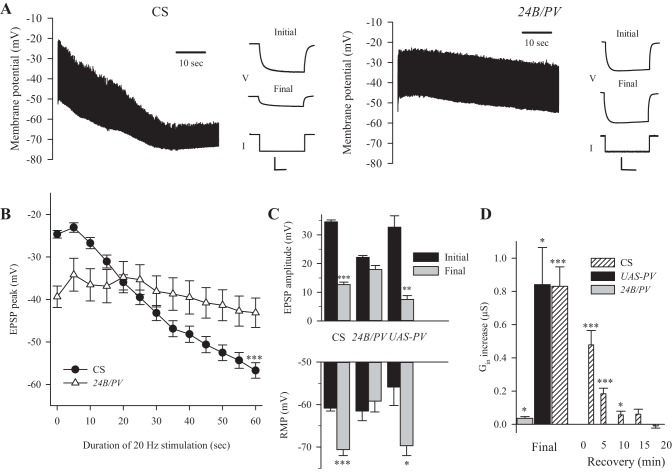Fig. 1.
The effect of repetitive synaptic activity on excitatory postsynaptic potential (EPSP) amplitude, resting membrane potential (RMP) and input conductance (Gin) in control larvae and larvae expressing parvalbumin (24B/PV) in the muscle. A: for muscle fiber 6, EPSPs recorded during 20-Hz stimulation for 60 s (every other EPSP is shown) and current (I) injection before (Initial) and after (Final) stimulation are shown. Calibration for I injection: Canton-S (CS): voltage (V) = 15 mV, 100 ms; 24B/PV: V = 10 mV, 100 ms. I amplitude was 5 nA for both. B: combined data showed that the EPSP peak became more negative during 20-Hz stimulation for CS larvae (n = 55). 24B/PV larvae (n = 8) showed no significant change in the EPSP peak during 20-Hz stimulation. C: the initial and final values measured at the beginning and end of 20-Hz stimulation. For control larvae (CS and UAS-PV, n = 5), the final EPSP amplitude was significantly smaller than the initial one, and the final RMP was significantly greater than the initial RMP. For 24B/PV larvae, the final EPSP amplitude and RMP were not significantly different from the initial ones. D: for control larvae, there was a significant increase in Gin at the end of stimulation (final Gin was measured 1 s after the last EPSP). For 24B/PV larvae, there was also a significant increase in Gin, but it was smaller than that seen in the controls. For CS, Gin was followed for 20 min after stimulation, and a significant increase was still seen 10 min poststimulation. Values are means ± SE. For all statistical tests, comparisons were made to the initial value. *P < 0.05, **P < 0.01,***P < 0.001, paired t-test.

